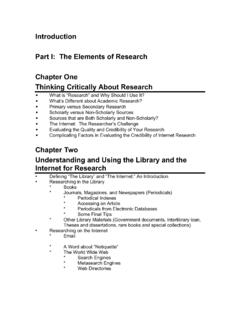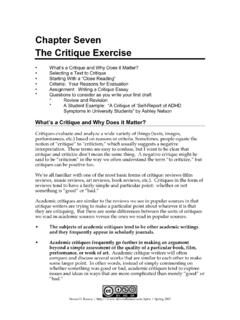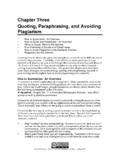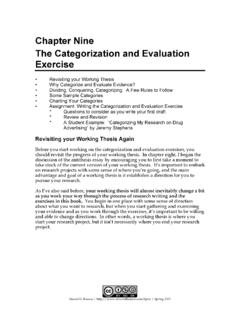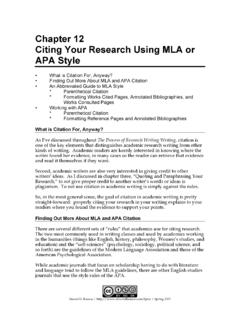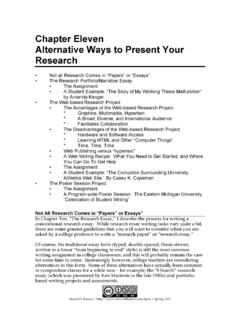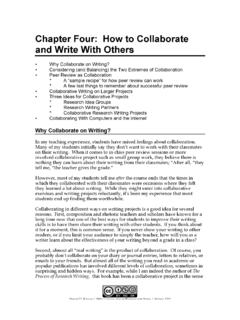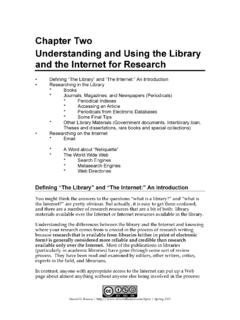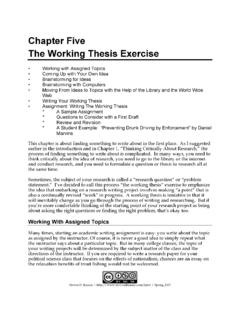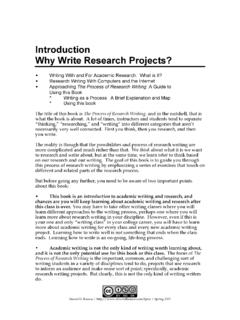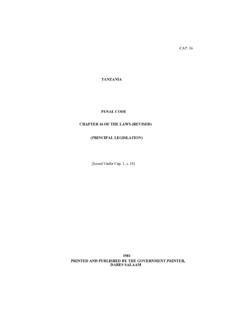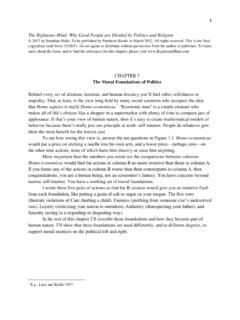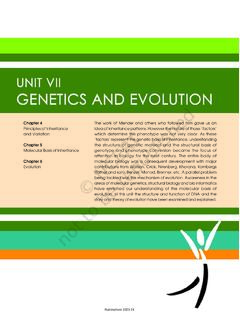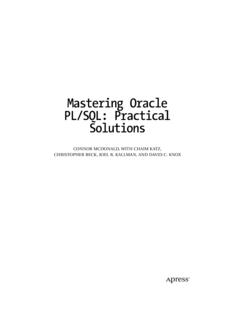Transcription of Chapter Six The Annotated Bibliography Exercise
1 Steven D. Krause | | Spring 2007 Chapter Six The Annotated Bibliography Exercise What is an Annotated Bibliography ? Why Write Annotated Bibliographies? How many sources do I need? Using Computers to Write Annotated Bibliographies The Process of Writing the Annotated Bibliography * A Sample Assignment * The Annotated Bibliography and Collaboration * Questions to Ask while Writing and Researching * Review and Revision What is an Annotated Bibliography ? As you develop a working thesis for your research project and begin to collect different pieces of evidence, you will soon find yourself needing some sort of system for keeping track of everything. The system discussed in this Chapter is an Annotated Bibliography , which is a list of sources on a particular topic that includes a brief summary of what each source is about.
2 This writing Exercise is a bit different from the others in this part of The Process of Research Writing in that isn t an essay per se; rather it is an ongoing writing project that you will be building as you discover new pieces of evidence for your research project. Here is an example of an entry from an Annotated Bibliography in MLA style: Parsons, Matt. protecting children on the Electronic Frontier: A Law Enforcement Challenge. FBI Law Enforcement Bulletin (2000): 22-26. This article is about an educational program used by the Navy to educate people in the Navy and their families about some of the things that are potentially dangerous to children about the Internet. Parsons says that the educational program has been effective. Annotated Bibliography entries have two parts. The top of the entry is the citation.
3 It is the part that starts Parsons, Matt and that lists information like the name of the writer, where the evidence appeared, the date of publication, and other publishing information. The Process of Research Writing Chapter Six, The Annotated Bibliography Exercise , 2 Steven D. Krause | | Spring 2007 Hyperlink: For guidelines on how to properly write citations for your Annotated bibliographies, see Chapter 12, Citing Your Research Using MLA or APA Style. The second part of the entry is the summary of the evidence being cited. A good Annotated Bibliography summary provides enough information in a sentence or two to help you and others understand what the research is about in a neutral and non-opinionated way. The first two sentences of this annotation are an example of this sort of very brief, just the facts sort of summary.
4 In the brief summaries of entries in an Annotated Bibliography , stay away from making evaluations about the source I didn t like this article very much or I thought this article was great. The most important goal of your brief summary is to help you, colleagues, and other potential readers get an idea about the subject of the particular piece of evidence. Summaries can be challenging to write, especially when you are trying to write them about longer and more complicated sources of research. Keep these guidelines in mind as you write your own summaries. Keep your summary short. Good summaries for Annotated bibliographies are not complete summaries; rather, they provide the highlights of the evidence in as brief and concise a manner as possible, no more than a sentence or two. Don t quote from what you are summarizing.
5 Summaries will be more useful to you and your colleagues if you write them in your own words. Instead of quoting directly what you think is the point of the piece of evidence, try to paraphrase it. (For more information on paraphrasing your evidence, see Chapter 3, Quoting, Paraphrasing, and Avoiding Plagiarism ). Don t cut and paste from database abstracts. Many of the periodical indexes that are available as part of your library s computer system include abstracts of articles. Do no cut this abstract material and then paste it into your own Annotated Bibliography . For one thing, this is plagiarism. Second, cutting and pasting from the abstract defeats one of the purposes of writing summaries and creating an Annotated Bibliography in the first place, which is to help you understand and explain your research. Different writers will inevitably write slightly different summaries of the same evidence.
6 Some differences between different writers summaries of the same piece of evidence result from different interpretations of what it important in the research; there s nothing wrong with that. The Process of Research Writing Chapter Six, The Annotated Bibliography Exercise , 3 Steven D. Krause | | Spring 2007 However, two summaries from different writers should both provide a similar summary. In other words, its not acceptable when the difference of interpretation is the result of a lack of understanding of the evidence. Why Write Annotated Bibliographies? An Annotated Bibliography is an excellent way to keep track of the research you gather for your project. Make no mistake about it it is extremely important that you keep track of all of your evidence for your research project, and that you keep track of it from the beginning of the process of research writing.
7 There s nothing more frustrating than finding an excellent article or book Chapter you are excited about incorporating into your research project, only to realize you have forgotten where you found the article or book Chapter in the first place. This is extremely frustrating, and it s easily avoided by doing something like writing an Annotated Bibliography . You could use other methods for keeping track of your research. For example, you could use note cards and write down the source information as a proper citation, then write down the information about the source that is important. If the material you know you want to use from a certain source is short enough, you might even write a direct quote, which is where you write down word for word what the source says exactly as it is written. At other times, you can write a paraphrase, which is where you write down what the source means using your own words.
8 While note cards and other methods have their advantages, Annotated bibliographies are an extremely useful tool for keeping track of your research. An Annotated Bibliography : Centralizes your research into one document that you can keep track of both as a print-out of a word-processed file and as a file you save electronically. Allows you to copy and paste citation information into the works cited part of your research project. An Annotated Bibliography also gives you the space to start writing and thinking a bit about how some of your research might fit into your project. Consider these two sample entries from an Annotated Bibliography from a research project on pharmaceutical advertising: Siegel, Marc. Fighting the Drug (ad) Wars. The Nation 17 June 2002: 21. Siegel, who is a doctor himself, writes about how drug advertising has undermined the communication between The Process of Research Writing Chapter Six, The Annotated Bibliography Exercise , 4 Steven D.
9 Krause | | Spring 2007 doctors and patients. He says that drug ads have driven up the costs of prescription drugs, particularly big selling drugs like those for cholesterol. Wechsler, Jill. Minority Docs See DTC Ads as Way to Address Race Gap. Pharmaceutical Executive May 2002: 32, 34. WilsonSelect Database. Eastern Michigan University Halle Library. 20 October 2002. < >. This article is about a study that said that African-American doctors saw advertising of prescription drugs as a way of educating their patients. The ads are useful because they talk about diseases that affect African-Americans. Even from the limited amount of information available in these entries, it s clear that a relationship between these articles exists. Both are similar articles about how the doctor/patient relationship is affected by drug advertising.
10 But both are also different. The first article is from the newspaper The Nation, which is in many ways similar to an academic journal and which is also known for its liberal views. The second article is from a trade journal (also similar to academic journals in many ways) that obviously is an advocate for the pharmaceutical industry. In other words, in the process of compiling an Annotated Bibliography , you are doing more than keeping track of your research. You are starting to make some comparisons and beginning to see some relationships between your evidence, a process that will become increasingly important as you gather more research and work your way through the different exercises that lead to the research project. But remember: However you decide to keep track of your research as you progress through your project Annotated Bibliography , note cards, or another method the important thing is that you need to keep track of your research as you progress through your project!
